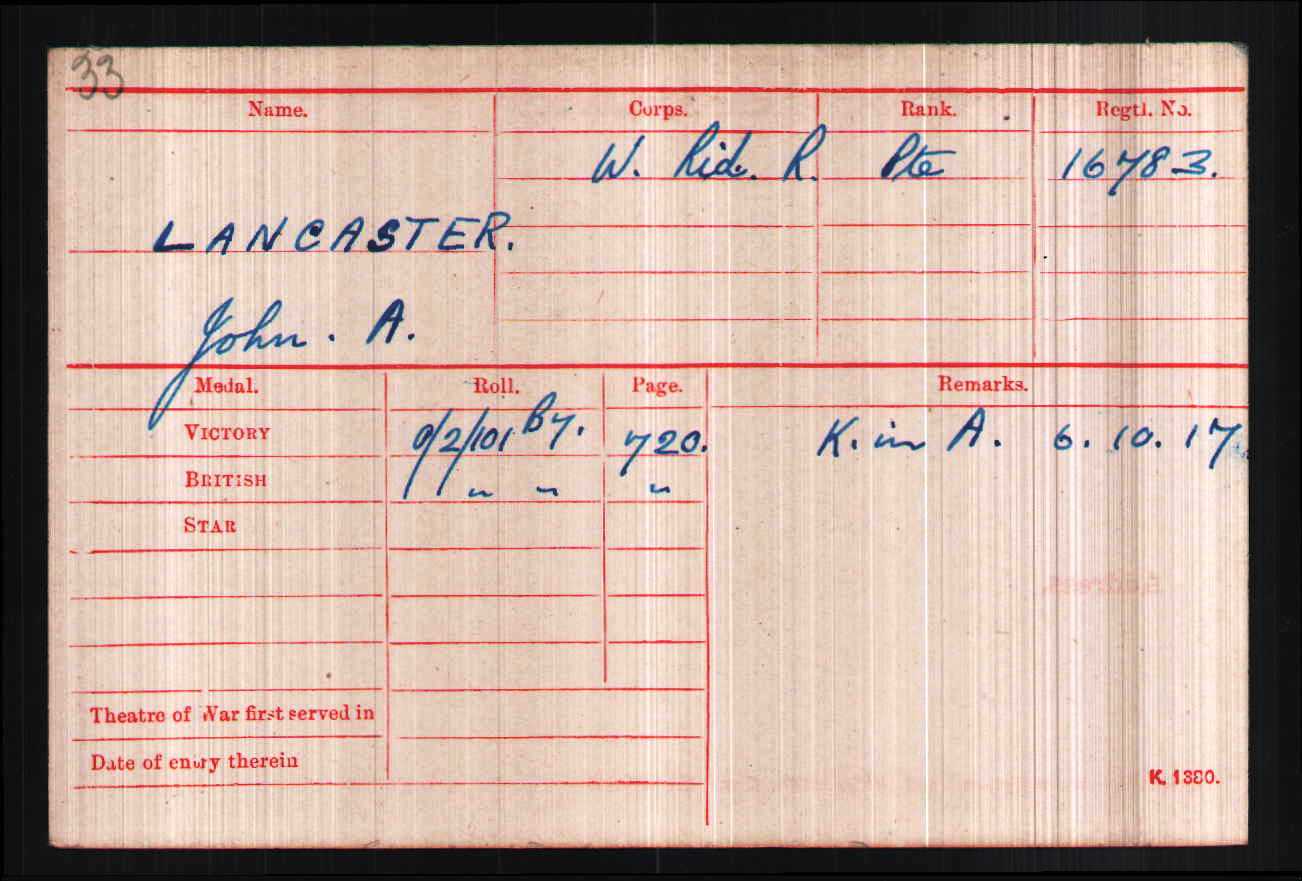
Submitted by Glennis Robson.
John Albert Lancaster was my uncle, he was my mother’s elder brother (13 years older). My mother spoke of much loved brother who was a source of goodness and “spoilt” his baby sister.
On receiving the news of his death my grandmother picked my mother up from school. They made their way home down the back lanes to hide their tears from passers by.
“Jack”,as he was known, was killed on the 16th of October 1917 at hill 60 in Flanders aged 19 after only a few months at the front.
He enlisted in the Duke of Wellington’s (West Riding) regiment on the 6th of December 1916 in Newcastle. His father William, a farrier, also joined up declaring that if his son was prepared to fight so was he. Unlike his son he survived the war. Having no known grave his name is on the Menin Gate. In 1988 my husband Keith and I visited the Western Front to see his name and the battlefield where he died. Since then “our Jack” has been in the consciousness of the wider family. Every November we place a poppy cross by my mother’s grave-stone in St Mary’s churchyard.

Explore more memories from the ribbon
-
Flora Sandes
Researched by John Mills. Flora Sandes was the only woman to officially fight on the front line during WW1, having joined the Serbian Army. Flora was born on the 26th January 1876 in Nether Poppleton, near York, the youngest of eight children. From an early age she exhibited an adventurous nature, a real tomboy, somewhat surprising for the daughter of a vicar! At the aged of 9 the family moved to rural Suffolk. Even her middle class upbringing didn’t dull her desire for adventure. After school she trained as a stenographer in London and scrapped together all her money, and together with the proceeds of a legacy from an uncle she went off to see the world travelling to places like Egypt, Canada and America. Flora was 38 years old when WW1 broke out and was living in London at the time. She enlisted as an Ambulance Service Volunteer and just 8 days later she was on her way to Serbia with the first volunteer unit to leave Britain. She worked in Military Hospitals and by October 1915 was fluent in the Serbian language. She eventually enlisted in the Serbian Army, one of the few countries in the world that accepted female soldiers. She soon made a name for herself, rising through the ranks to Sergeant within a year. It wasn’t just soldiering that Flora matched her male counterparts. She could hold her own racing cars, shooting, smoking and drinking. She survived the front line fighting, received a terrible shrapnel…
-
Hugh Morkill
Hugh Bernard (Bobby) Morkill Hugh was born on the 1st October 1896 at Austhorpe Lodge, Whitkirk, Leeds. His father, John William Morkill, had married Hannah Shaw Hobson in Edinburgh in 1889 and they would have 4 children, Hugh being the third youngest. Hugh, like his father, was educated at Radley College Oxford enrolling there in 1910. He was a keen sportsman, being part of the College cricket XI in 1915 and a member of the first ever Rugby XV in 1914. During 1915 he was a college prefect. After college he enrolled at Sandhurst and was commissioned as a 2nd Lieutenant in December 1915. On the 22nd December 1915 he joined the Yorkshire Regiment. In 1916 he was in India with the 1st Battalion. However, becoming restless with the relative inactivity he joined the Royal Flying Corps. He was sent to the 20th Training Wing in Egypt completing his ground course in September 1917. He then completed his flying training and qualified as a pilot on the 13th October 1917. Hopes of active service were dashed when he was retained as an instructor. However, the 19th September 1918 would see his first air action against Turkish positions in Palestine. Apparently a pet ring-tailed lemur called Jimmy often accompanied Hugh on his flights! In 1922 he returned to the Yorkshire Regiment, eventually rising to the rank of Lieutenant-Colonel in 1940. He died in May 1991. Mike Senior, who knew Hugh Morkill in his later years recently visited the museum and recounted…
-
John Mattison
Alyson Swift contacted us through our website to tell us about her great grandfather, John Mattison. John was from Richmond and was called up on 10th May 1917, joining the Royal Flying Corps. While he may look very smart in what is known as his ‘Maternity’ pattern tunic and side cap, Alyson wanted to draw a different aspect of his role in the First World War to our attention: “He was an entertainer in the the camp concert party. He and his party won a talent contest at the Croydon Empire Theatre. He sang ‘the Laddies who fought and won’ and ‘keep right on to the End of the Road’ for which they won 20 pound!!”
